A Tale of Two Geodes
On December 6th 2004 I got 2 Geode systems. A mini-itx system
came in the mail and I also purchased an AMD PIC
from the local phone company.
Monday was the first day the PIC was available in Anguilla
and I bought the first one.
The PIC has been on
slashdot
and
linuxdevices. It came with a USB-ethernet adapter and a
USB-ADSL adapter. The mouse and keyboard are also USB (very sensible).
My goal was to make a Linux system with no moving parts.
It seems that fans and disks are the causes of most failures.
Linux has JFFS2, a flash filesystem with compression.
I bought 2 GB of flash on Amazon for only $148.
With
Damn Small Linux fitting in 50 MB.
[On 9/7/2006 Amazon had 2 GB flash for $46, on 12/7/2007 Amazon had 4 GB
for $31.53, Frys had 2 GB for $15 - 10 times cheaper than 3 years ago].
For many applications you don't need a really fast CPU
and 1 GB with compression is enough space.
So a system with no moving parts is reasonable today.
The PIC is a very low power system, I measured 8 watts for the computer
(the CPU spec is 1 watt and the disk spec about 4 watts).
The monitor uses either 4 or 53 watts
depending on if it is active or sleeping.
This is like 100 watts less than some other machines we have.
At island electric rates this should save more than $200 each year,
if the machine is on all the time.
The disk never stops spinning but you can only hear it
if your ear is closer than about 8 inches.
The PIC is also low cost. Without monitor it has a MSRP of $185, though on
this tropical island it is $251 (given shipping and duty rates
here this is not bad). With the monitor it is $372 here.
Also, the phone company will let
people pay $40/month on their phone bill.
The PIC runs Windows-CE 5.0 and will not let me
install any software.
It has a browser, editor, spreadsheet, email, etc. So most people
can probably do what they want on this computer. My main
complaint is that it does not have Java, so some web pages
do not work.
The real fun is that the PIC hardware looks fantastic for making
a router, firewall, print server, nameserver, etc. if we can
get Linux running on it.
However, the usual ways of getting to the BIOS settings do not work,
so we can not tell it to boot from a USB-flash.
So now we have to open it up and see
if we can boot Linux from an IDE device. I also wanted to look inside.
I might have voided the warranty. Does not really look
like they want you to open it up.
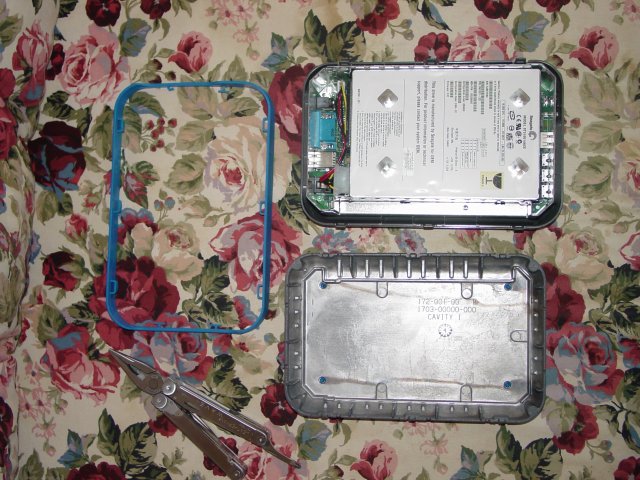
The PIC is just the right size to hold a 3.5 inch disk.
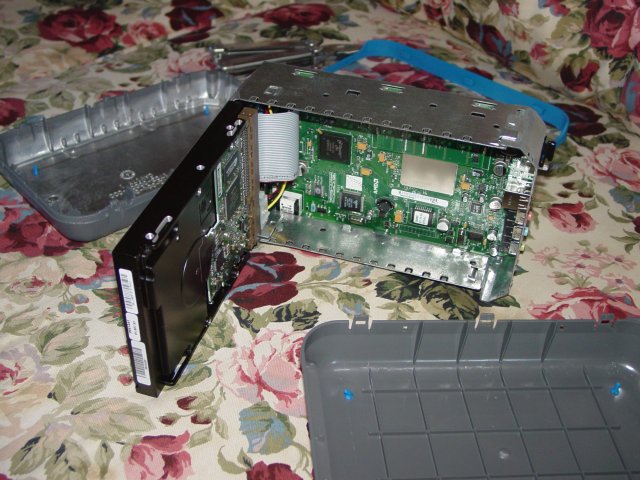
Note there is no fan or even heat sink on the CPU.
What must be the memory card is laying flat just
above the CPU.
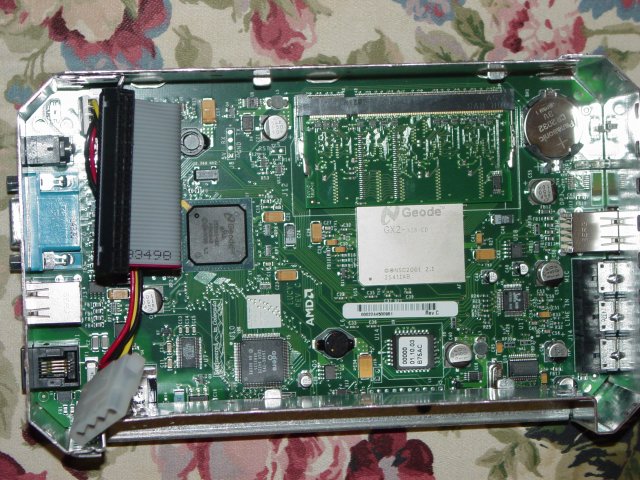
Off with the disk and on with the IDE-compact-flash.
But it would not boot Linux.
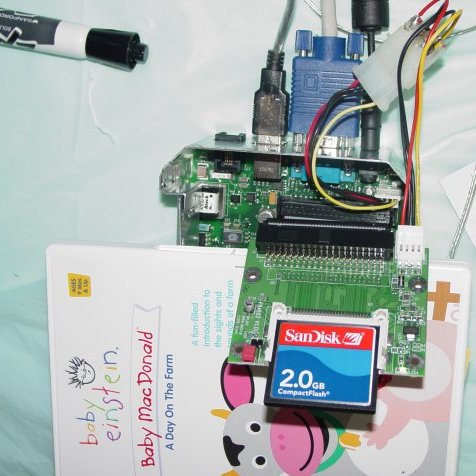
So we put the flash back in the other Geode system.
This system has no trouble running Linux (Fedora Core-3) off the flash.
This is a mini-itx with a 1 Ghz Geode (1500+). It uses the AMD K7 core.
This CPU is 6 watts, so it has a heat sink.
The power supply is DC-to-DC, so there is no heat.
The system runs fine without the little fan plugged in (at least
with the case off).
So we have a 1 Ghz system with
no moving parts! Only about 4 years ago an AMD K7-core Athlon at 1 Ghz was the fastest
PC you could get. Cool.

The PIC is back together and playing missile command.
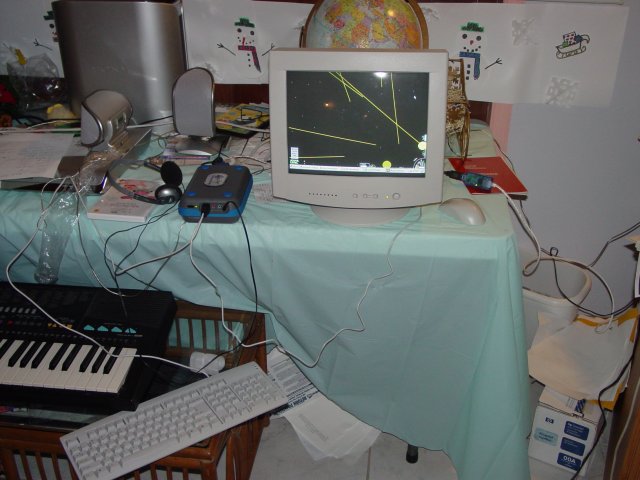
Another thing that causes computer failures on tropical
islands is bugs or geckos getting inside. Since the PIC
does not have a fan it does not have big openings for
things to crawl inside. So it should last very well.
Someone at AMD said that a future version of the PIC
could come standard with Flash instead of a hard disk.
This might be a year after the first model.
This type of computer should last just about forever.
I wonder how small it will be.
Info after above
I
posted on slashdot. The most interesting thing so far is that
General Software made a crypto BIOS for PIC with a
Boot Secure
feature so only the desired software will load.
I contacted gensw.com to see if there was some keyboard sequence
that would override this and they said
they were "instructed by AMD to refer all inquiries
back to AMD." When I contacted AMD, the answer was, "There are currently
no plans to offer a PIC with boot software that will allow you to load an
alternate O/S.".
Also someone suggested just copying the hard disk onto flash.
We tried this and it did act differently. With the first flash
it did the memory/disk diagnostics and then halted. With this
copy it does the diagnostics pauses, then loops and does the
diagnostics again. The disk is 10 GB and the flash is 2 GB,
so I suspect that we just could not fit enough to make it work.
After buying these systems a new board came out, the
Tyan Tomcat K7M.
This is a Geode motherboard that looks very nice.
This should work fine with Linux and also be very cheap.
Anguilla's main industry is tourism. The PIC with Windows-CE
makes a great computer for guests to use since they can not
mess it up. It seems several people here will be using it
for that.
Some people are worried that flash can wear out. But flash is
a bit more reliable and much bigger these days, so it is hard
to wear out now. Current Flash
can do around 100,000 writes to a given block before wearing out.
The Linux JFFS2 (journalling flash filesystem 2) spreads the
writes out over the flash. It seems CF modules even have
logic to spread writes around (heard on slashdot). So for a
2 GB flash module you have to do like 200 TB of writes.
If a computer writes at 1 MB per minute (mine average less than this)
this would take 380 years. This is not something to worry about.
Mechanical things break faster (disks, fans).
Anyone is welcome to use any of these pictures in any way
they want. No need to credit me.
PIC Can not be fixed - 1/6/05 update
My 1-year-old son pulled on the keyboard cable and the whole
PIC fell from a table to a coffee table (about a 1 foot drop)
while it was running. After this it did not work, just saying
"hard disk failure". This could happen to any running
disk dropped that far. But a bigger computer does not slide
off a table so easy when a 1-year-old pulls on a cable.
I took the PIC to the company I bought it from, Cable and Wireless,
and explained what happened. I asked if they
could give/sell me a new disk. They said that these boxes
can not be opened and so I have to buy a whole new computer.
A 10 GB harddisk is cheap. A whole new PIC is not so cheap.
I explained that they can be opened and if I could borrow
a PIC I could copy the harddisk off that one onto a new
disk for my machine. They said no.
I will try to find someone else who has a PIC and see if they
will let me borrow it and copy the data off their disk onto
a new disk for my machine.
Irony of Broken Disk
Of course if we had flash working in the PIC like I wanted,
instead of a disk with a low flying
head, it would almost certainly still work after a 1 foot drop.
The rest of the computer is fine, it can run the diagnostics,
check the memory, check the disk, and display the error.
If it did not have the crypto-bios, I could toss the drive and
put in flash (did not want the drive anyway).
Update 1/31/05 - Working Again
I got a drive in the mail from AMD with a note saying
"Thanks for your support! Your friends at AMD". We put
in this drive and everything is working fine again.
Thanks very much AMD! Really an excellent company.
This time I used some big quick-ties to attach my PIC to
the monitor's power and video cables behind the monitor.
My one year old should not be able to pull it off the
table now.
Update 2/2/05 - Linspire Linux on PIC
On the
amdboard they say Linspire will demo Linux on a PIC this month.
This would be very nice.
Update 6/10/05 UPS / still no Linux on PIC
Another interesting thing about a low power system is that your UPS
lasts much longer. If you have a UPS that will keep a 160 watt
server running for 30 minutes, then it would keep an 8 watt server
running for something like 10 hours.
Still have not found anyplace where you can get a PICs that runs Linux.
Update 9/9/06 - Rumors of Linux on PIC
Back in
May 2006, LinuxDevices says still no Linux on PIC
even 1.5 years after it came out. The crypto-BIOS has
not been hacked to load Linux.
There is a
report of a new PIC that can run Linux, but it looks
like they just got confused by what I think is a
report that with a BIOS update you can load Linux.
Now to figure out if I can get a BIOS update.
Update 11/13/06 - PIC Canceled
The
PIC is canceled and
gone.
I strongly feel that if the BIOS had not crippled the
hardware so it could only load Windows CE that the PIC hardware could have
been a big success. Windows CE does not let you load any of your own software.
If we could load the latest version of Windows XP or Linux on the PIC,
there would be far more customers. It is like AMD cut out 99% of their
potential market by limiting themselves with this BIOS. A computer that can not
learn any new tricks is a stupid computer.
In reaction to how locked down the computer was, the
first comment when I posted on slashdot was "It might as well not even have a keyboard or monitor
port. Yeesh.". At the time I laughed. But looking back it is not funny, but sad.
The truth is that my PIC is so locked down it is the least used computer I have ever owned, by far.
At an absolute mimimum the browser should have supported Java so at least web
software could run. Then at least my kids could have used it to play Internet Java games.
Oh well. I hope AMD learns the right lesson and comes out with a tiny Flash based system,
with no moving parts, and a reasonable BIOS. The
One Laptop Per Child project is sort of this. But
I rather have a box that I plug a nice keyboard and monitor into. A monitor can
last a very long time, as can a keyboard. But a 3-year old computer is going
to be about 1/4th the power of a comparable current model. So it makes sense
to be able to keep your keyboard and monitor and just replace the computer.
You can't do that with OLPC. Also, for many things like routers, nameservers,
printservers, etc we don't need a monitor.
Update 6/11/07 - PIC Runs Linux
The PIC has made a comeback as the
decTOP and is for sale without OS for $99. The really exciting part is that
now it can run Linux!
I have ordered a decTOP with the new bios. Because I live on an island in the caribbean, I probably
won't get it till around July 10th. I will load linux on it and update this page
as soon as I have done so.
Update 7/19/07 - URL for how install Linux on PIC
Jonathan Scott has
written up how he installed Ubuntu on his decTOP.
Update 12/11/07
My main problem with the decTOP is that a standard desktop Ubuntu install wants about 3 times
the 128 MB of memory that decTOP has. I ordered a similar geode based unit from
koolu.com that has 512 MB and better graphics.
I confirmed with koolu that it can boot from USB. Also, it comes with Ubuntu on
disk, but when the disk dies (or maybe sooner) my plan is to convert to USB flash.
They also indicated that a future version might come with flash instead of disk,
but they did not have that option yet.
Update 12/17/07
My koolu.com worked right out of the box.
I hooked up a wireless keyboard/mouse from Microsoft and a monitor from
Frys and it worked fine. Networking just worked, keyboard, mouse, monitor,
everything nice and easy. The speed for browsing the web is good.
I am very happy with this system. I will probably buy more.
Vincent Cate